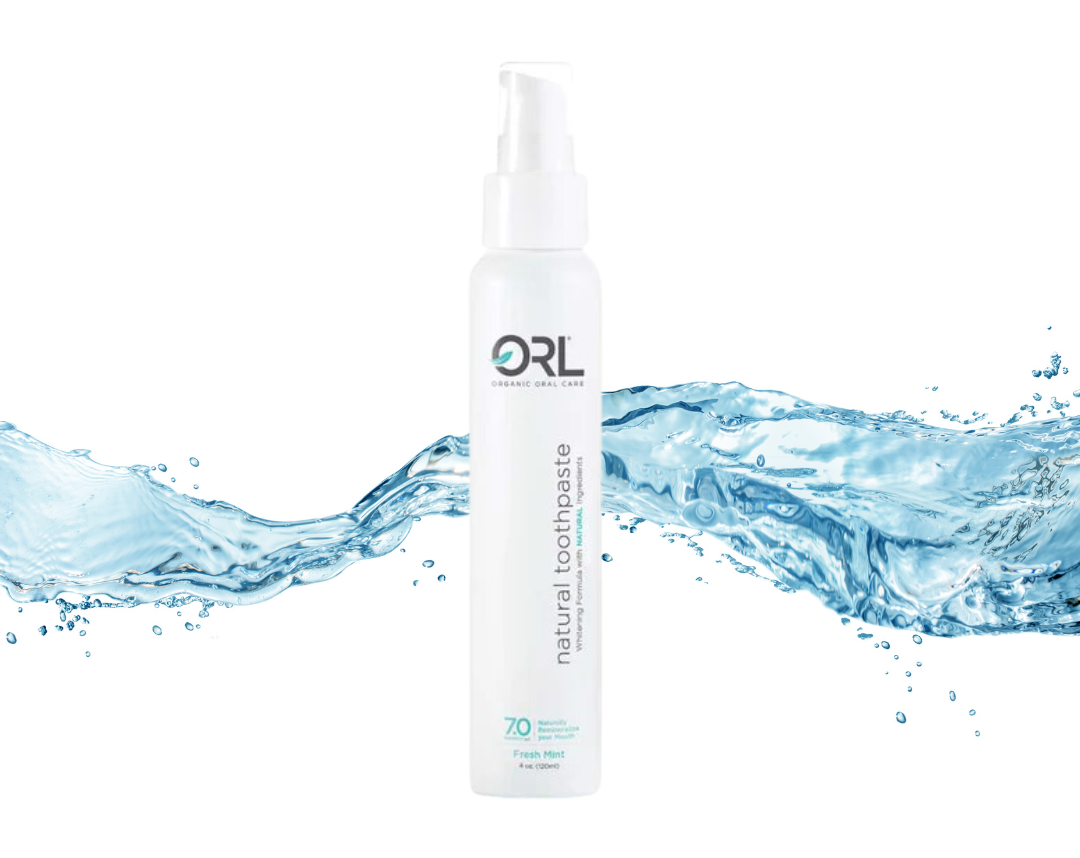A natural ingredient is making a splash in the oral hygiene scene, challenging fluoride’s #1 seat as the go-to for healthier, stronger teeth.
It’s called natural Hydroxyapatite, and while you won’t find it in most big-name toothpaste brands, its effectiveness is backed by over four decades of research.
Intrigued? Read on to learn more about the many benefits of choosing a toothpaste with natural Hydroxyapatite.
What Exactly Is Hydroxyapatite?
Hydroxyapatite is a naturally-occurring form of calcium and the main constituent (97%) of tooth enamel—the hard, white outer layer of your teeth that protects the underlying tissues (dentin and pulp).[1] The high concentration of hydroxyapatite is what makes tooth enamel the hardest substance in the human body![2]
Maintaining healthy enamel is essential to your oral health and overall wellness. It protects the inner elements of the teeth from bacteria that can lead to cavities, infections, gum disease, and even tooth loss.
Hydroxyapatite also makes up 65% of bones and is used to help strengthen the bones of osteopathic patients.[3]
How Is Hydroxyapatite Used?
While fluoride is still a common ingredient in many toothpastes, several brands have switched from using fluoride as a key ingredient to using hydroxyapatite.
The switch is motivated by concerns about the potential adverse health effects of fluoride in adults and children and a demand for more natural, non-toxic oral hygiene options.
What Are the Benefits of Natural Hydroxyapatite Toothpaste?
There’s a reason (actually many!) more and more toothpaste brands are including hydroxyapatite in their formulas. Let’s take a look at the top benefits of this mineral:
#1: Remineralizes teeth, which helps prevent and heal cavities
Hydroxyapatite’s main claim to fame is its ability to remineralize (rebuild) tooth enamel without any known side effects. To understand the significance of this, let’s back up for a minute.
The bacteria in your mouth, which thrive on sugars in the foods and drinks you consume, generate acids that wear away at your teeth and cause mineral loss. This is called demineralization. Remineralization is the repair process that re-hardens teeth that have become softened by acids. Hydroxyapatite works by replacing the minerals your teeth lose.[4] By strengthening the enamel, your teeth are better protected against plaque, which can cause cavities and gum disease.
Hydroxyapatite also fills in tiny “fissures” in your teeth that would otherwise host bacteria that can lead to cavities and decay and has even been shown to shrink already-existing lesions of decay.[5]
#2: Non-toxic and bioavailable
One of the biggest drawbacks of including fluoride in toothpaste is that at high doses, fluoride is a neurotoxicant (a toxin that negatively affects the brain). This is of particular concern for children who have been found to use far more toothpaste than they should, which can lead to swallowing high levels of fluoride.[6]
Hydroxyapatite, on the other hand, is completely non-toxic, safe, and compatible with your body.[7] Remember, hydroxyapatite makes up the majority of tooth enamel, so when it’s applied to your teeth, your body immediately recognizes the compound and absorbs it down to the root.
This makes hydroxyapatite a great weapon against tooth decay, as it can reach down into the furthest areas of decay to rebuild enamel.
#3: Works just as well, if not better, than fluoride
You might be wondering how hydroxyapatite stacks up against fluoride. Good news: several studies comparing the two ingredients have found that hydroxyapatite either works just as well or better than fluoride for preventing and reversing enamel erosion and tooth decay.[8]
#4: Resistant to acidic pH
To avoid inflammation and oral disease, the pH balance of your mouth should remain around a neutral 7.0. Hydroxyapatite toothpaste helps teeth maintain this neutral pH by increasing their resistance to acids from sugar, which would otherwise break down enamel.[10]
#5: Promotes a healthy oral microbiome
Most toothpastes include ingredients like fluoride, triclosan, and alcohol that eliminate both the good and bad bacteria in the mouth. This is not a good thing, as the oral microbiome needs a healthy balance of bacteria to function properly.
Hydroxyapatite is unique in that it prevents bacteria from attaching to enamel just as effectively as antibacterial agents, but without killing the actual bacteria your mouth needs to be balanced and healthy.[11]
#6: May improve gum health
Preliminary research suggests that using hydroxyapatite toothpaste may help improve gum health in individuals with gum disease.[12] Improvements were seen with plaque control, bleeding gums, and pocket depth.
#7: Whitens your teeth
Functional benefits aside, hydroxyapatite is effective in making your smile whiter and brighter. It does this by filling in tooth enamel with healthy tooth structure, making them appear whiter.[9]
Make the Switch to Natural
With all these incredible benefits, it’s no wonder more brands and consumers are hopping on the natural Hydroxyapatite train. Not only is it highly effective for building and maintaining strong, healthy, white teeth, but it’s also safe, non-toxic, and biocompatible. Sorry fluoride, you’ve been dethroned!
If you’re interested in trying hydroxyapatite toothpaste for yourself, consider ORL products. We’re committed to providing the best in natural and organic oral care and include hydroxyapatite in all of our fluoride-free organic toothpastes.
Our pH-balanced, vegan formulas are designed to help kill bacteria, strengthen enamel, whiten your smile, and neutralize oral acids—all while leaving you with minty fresh breath.
Our products are also free of over 100 harmful ingredients found across many national brands! Click here to compare the toothpaste or mouthwash you’re currently using to our natural and organic toothpaste and mouthwash.
Up your oral health game by trying ORL products today!
References:
- Meyer, F., Amaechi, B. T., Fabritius, H.-O., & Enax, J. (2018). Overview of calcium phosphates used in biomimetic oral care. The Open Dentistry Journal, 12(1), 406–423. https://doi.org/10.2174/1874210601812010406
- S. Department of Health and Human Services. (2020, July 1). Complexity of human tooth enamel revealed at atomic level in NIH-funded study. National Institutes of Health. Retrieved November 6, 2022, from https://www.nih.gov/news-events/news-releases/complexity-human-tooth-enamel-revealed-atomic-level-nih-funded-study
- Hydroxyapatite. Hydroxyapatite - an overview | ScienceDirect Topics. (n.d.). Retrieved November 6, 2022, from https://www.sciencedirect.com/topics/chemical-engineering/hydroxyapatite
- Pepla, E., Besharat, L. K., Palaia, G., Tenore, G., & Migliau, G. (2014, November 20). Nano-hydroxyapatite and its applications in preventive, restorative and Regenerative Dentistry: A review of literature. Annali di stomatologia. Retrieved November 6, 2022, from https://www.ncbi.nlm.nih.gov/pmc/articles/PMC4252862/
- Subrata Nath | graduate research assistant | Ph.D. in additive ... (n.d.). Retrieved November 6, 2022, from https://www.researchgate.net/profile/Subrata-Nath-2
- Use of toothpaste and toothbrushing patterns among children and ... (n.d.). Retrieved November 6, 2022, from https://www.cdc.gov/mmwr/volumes/68/wr/pdfs/mm6804a3-H.pdf
- Coelho, C. C., Grenho, L., Gomes, P. S., Quadros, P. A., & Fernandes, M. H. (2019, July 30). Nano-hydroxyapatite in oral care cosmetics: Characterization and cytotoxicity assessment. Nature News. Retrieved November 6, 2022, from https://www.nature.com/articles/s41598-019-47491-z?utm_medium=affiliate&utm_source=commission_junction&utm_campaign=CONR_PF018_ECOM_GL_PHSS_ALWYS_DEEPLINK&utm_content=textlink&utm_term=PID100090071&CJEVENT=c1f34ef35bb511ed83d80baf0a1c0e10
- Amaechi, B. T., AbdulAzees, P. A., Alshareif, D. O., Shehata, M. A., Lima, P. P., Abdollahi, A., Kalkhorani, P. S., & Evans, V. (2019). Comparative efficacy of a hydroxyapatite and a fluoride toothpaste for prevention and remineralization of dental caries in children. BDJ Open, 5(1). https://doi.org/10.1038/s41405-019-0026-8
- Niwa, M., Sato, T., Li, W., Aoki, H., Aoki, H., & Daisaku, T. (2001). Polishing and whitening properties of toothpaste containing hydroxyapatite. Journal of Materials Science: Materials in Medicine, 12(3), 277–281. https://doi.org/10.1023/a:1008927502523
- Remineralization of early caries by a nano hydroxyapatite dentifrice. (n.d.). Retrieved November 6, 2022, from https://www.researchgate.net/profile/Bennett-Amaechi/publication/221690050_Remineralization_of_early_caries_by_a_nano-hydroxyapatite_dentifrice/links/0fcfd502d03a6c7db7000000/Remineralization-of-early-caries-by-a-nano-hydroxyapatite-dentifrice.pdf
- Meyer, F., & Enax, J. (2019). Hydroxyapatite in oral biofilm management. European Journal of Dentistry, 13(02), 287–290. https://doi.org/10.1055/s-0039-1695657
- Harks, I., Jockel-Schneider, Y., Schlagenhauf, U., May, T. W., Gravemeier, M., Prior, K., Petersilka, G., & Ehmke, B. (2016). Impact of the daily use of a microcrystal hydroxyapatite dentifrice on de novo plaque formation and clinical/microbiological parameters of periodontal health. A randomized trial. PLOS ONE, 11(7). https://doi.org/10.1371/journal.pone.0160142



